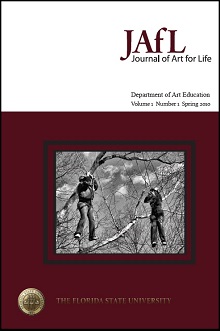Moving beyond the Stratification of Mexican Identity through Art
Keywords:
social justice, Mexican-American, stratification, identity, visual literacy, cultural resources, indigenous, art education, metaphor, mestizoAbstract
The determination of societal worth among Mexicans in Mexico and the United States has traditionally been decided by color (e.g. skin tone, hair texture, eye color). Such social stratification negatively affects education and healthcare access and has been correlated to increased delinquency rates as well as to violent crime. These issues raise significant social justice concerns. Art in Mexican societies is used as a way to challenge as well as to instate concepts relating to identity and socially ascribed roles. Although issues of stratification still abound, this paper will present an overview of the use of art within Mexican societies as a method of identity-affirmation and identity-reconstruction. Examples will be provided as to the role of art in informing community members of social injustices, implementing visual literacy, and in re-constructing visual associations affiliated with identity. The potential of art education to increase social interaction, facilitate assimilation, and enhance cross-cultural understanding will also be mentioned.Downloads
Published
2010-03-15
Issue
Section
Articles
License
Authors who publish with this journal agree to the following terms:- Authors retain copyright and grant the journal right of first publication with the work simultaneously licensed under a Creative Commons Attribution License that allows others to share the work with an acknowledgement of the work's authorship and initial publication in this journal.
- Authors are able to enter into separate, additional contractual arrangements for the non-exclusive distribution of the journal's published version of the work (e.g., post it to an institutional repository or publish it in a book), with an acknowledgement of its initial publication in this journal.
- Authors are permitted and encouraged to post their work online (e.g., in institutional repositories or on their website) prior to and during the submission process, as it can lead to productive exchanges, as well as earlier and greater citation of published work (See The Effect of Open Access).


